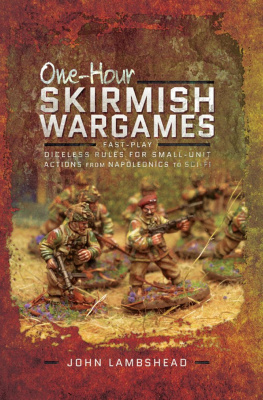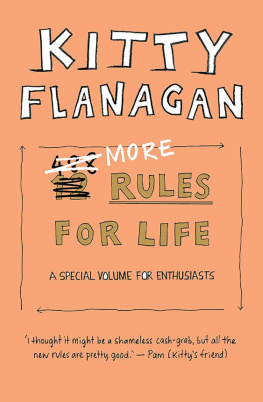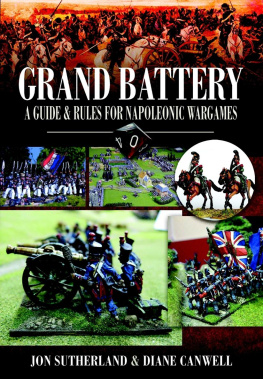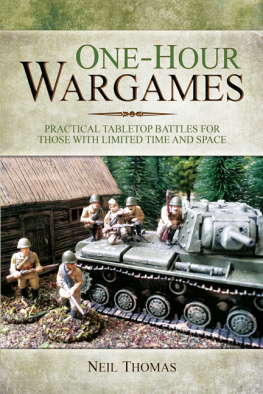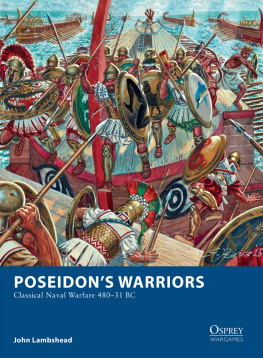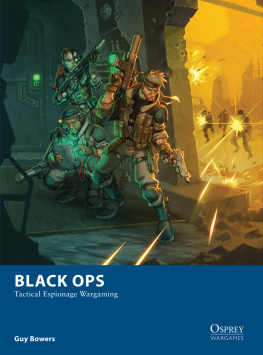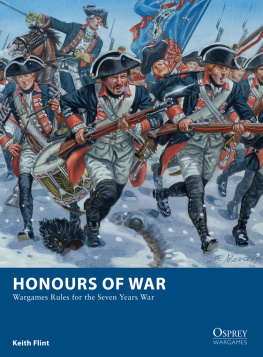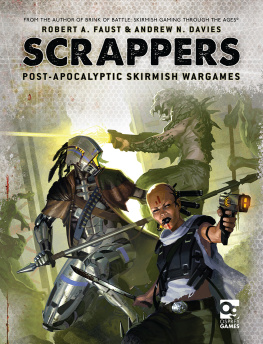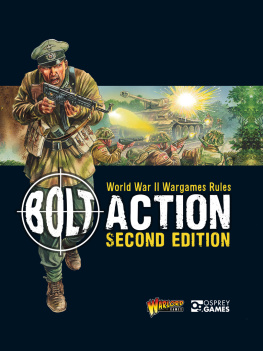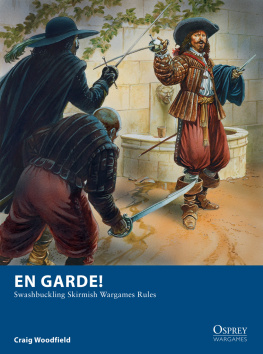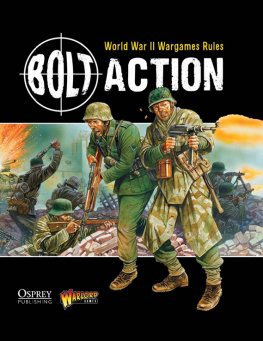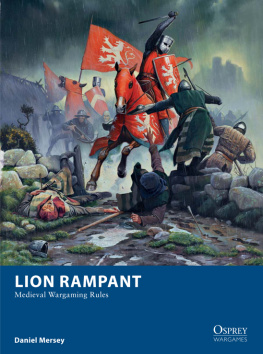Pagebreaks of the print version

One-Hour Skirmish Wargames
Dedicated to Shaun Murphy for his infinite patience in playtesting my designs and just for being a mate.
One-Hour Skirmish Wargames
By John Lambshead
First published in Great Britain in 2018 by
Pen & Sword Military
An imprint of
Pen & Sword Books Ltd
Yorkshire Philadelphia
Copyright John Lambshead 2018
ISBN 978 1 52670 004 9
eISBN 978 1 52670 006 3
Mobi ISBN 978 1 52670 006 3
The right of John Lambshead to be identified as Author of this work has been asserted by him in accordance with the Copyright, Designs and Patents Act 1988.
A CIP catalogue record for this book is
available from the British Library.
All rights reserved. No part of this book may be reproduced or transmitted in any form or by any means, electronic or mechanical including photocopying, recording or by any information storage and retrieval system, without permission from the Publisher in writing.
Croydon, CR0 4YY.
Pen & Sword Books Limited incorporates the imprints of Atlas,
Archaeology, Aviation, Discovery, Family History, Fiction,
History, Maritime, Military, Military Classics, Politics, Select,
Transport, True Crime, Air World, Frontline Publishing, Leo
Cooper, Remember When, Seaforth Publishing, The Praetorian
Press, Wharncliffe Local History, Wharncliffe Transport,
Wharncliffe True Crime and White Owl.
For a complete list of Pen & Sword titles please contact
PEN & SWORD BOOKS LIMITED
47 Church Street, Barnsley, South Yorkshire, S70 2AS, England
E-mail:
Website:
Or
PEN AND SWORD BOOKS
1950 Lawrence Rd, Havertown, PA 19083, USA
E-mail:
Website: www.penandswordbooks.com
Foreword
It is both an honour but also something of a daunting task to be asked to write the follow up to Neil Thomas hugely successful book on One-Hour Wargames . Neil set a high bar with his ground-breaking work that very much captured the mood of our times. Not everyone always has the time to read complicated rules or to play an all-day game on large tables involving large numbers of models.
It is worth stopping to consider what made Neils book so successful. I would suggest the following points might be part of the explanation, other than the obvious that the rules can be quickly grasped, and the games easily played in an hour or two on a 3 by 3 table using 100 figures or less. Firstly, Neil shows that simple doesnt have to mean simplistic let alone facile; as has often been pointed out, chess is simple.
Secondly, he demonstrates that large and complicated is not synonymous with realistic. His rules cover nine eras ranging from the ancient world to World War Two, and capture the atmosphere and essence of each period by selectively tailoring a core rule philosophy. For example, the rules for the ancient period use a sequence of play reflecting the importance of the clash of spear and shield over shooting: Movement, Shooting, Hand-to-Hand Combat, and Elimination of Units. However the equivalent sequence of play for World War II rules is Movement, Observation, Shooting, and Eliminating Units, reflecting a quantum jump in firepower range and lethality.
There is a definite trend in wargaming towards slicker, faster, comprehensive, pre-packaged games that can be learnt and played in a few hours and its clear that this is more than just a transient fad. One has only to look at the direction rules are taking at the large commercial wargaming operations like Games Workshop for confirmation of the trend. Whether its because our world moves faster with instant and extensive communication, because of the greater demands placed upon our time, or something more subtle like the way we now take in information through screens rather than print, who knows? But, whatever, Neils book caught the zeitgeist of the day.
General Introduction
In general terms, skirmish in ordinary English means a short conflict which may range from an argument with ones spouse about whose turn it is to put out the rubbish to the sort of robust discussion that happens in pub car parks after last orders have been called.
In the military, the definition is rather more specific. It means a brief, unplanned encounter between small units of troops, ships or aircraft especially by advanced or outlying detachments of larger forces.
In wargaming, a skirmish was commonly seen as a game where one model represented one man or vehicle, as opposed to traditional wargames where twenty-four figures might represent a Roman cohort or Victorian rifle regiment. The simplicity of this definition is now muddied by company or platoon based games, including some of the most popular game systems in the hobby such as Warlord Games Bolt Action or Games Workshops Warhammer 40K . In such games, one model still represents a single person or vehicle BUT the models commonly move and fight in larger formations: the operational unit (OU) is not a single model but a squad of, say, ten models. An OU can be defined as the smallest number of models that move and fight independently. And when it comes to rules writing, its the OU that actually defines the scales and mechanics of the game.
Item: a skirmish wargame is where a single model not only represents one person or vehicle BUT that one model also represents an OU.
A good rule-of-thumb is that a single gamer can handle about twelve OUs in his army; more than this and the game can bog down as players get overwhelmed, fewer than this and there are not enough OUs to allow strategies so as to give players a challenging and enjoyable game. Of course, this figure isnt immutable very little is in game design. If the OUs all have universal, simple properties then you could easily double or treble the number that can be controlled. Conversely, if each OU is unique, with complicated, interacting special rules then even 6 or fewer OUs per army could prove challenging.
Skirmish games arent quite as old as wargaming itself but they do have quite a respectable pedigree. The first skirmish game of which I am aware was a set of Wild West gunfighter rules by Steve Curtis, Ian Colwill, and Mike Blake that was released in the early 1970s but no doubt there are earlier examples. 1975 saw the release of a seminal rule book just called Skirmish Wargaming by the redoubtable Donald Featherstone.
There is a school of thought that persists to this day that because skirmish wargaming involves few models that each model must have concomitantly complicated special rules. Often the player has been required to micromanage actions. For example a gunman model might not just shoot, but (i) locate the target, (ii) draw his pistol, (iii) cock his pistol, (iv) aim his pistol and (v) pull the trigger. The player might even be called upon to write out orders in advance detailing all these actions. This approach has meant that skirmish games have had a tendency to become complicated virtual models of real life.
I well recall playing a game of Cold War fighter combat (air games are often a sub-branch of skirmish games) in the early 80s where a single pass by two Tornados at an element of MIG 25s that might have taken ten to thirty seconds of real time actually required all afternoon to play. If game-time is longer than real-time then were doing something wrong. In many ways the development of cheap, powerful, digital games machines with excellent graphics has made such detailed wargames superfluous. Computers are good at creating a model of a world we call it virtual reality.

